Explore Hin Raab North – Koh Chang's Exclusive Dive Adventure
Imagine diving into an underwater kindergarten where fish schools are so dense, you feel like you're swimming through fish rather than water. Welcome to Hin Raab North – Koh Chang's crown jewel of coral diversity and one of the most exclusive dive sites in Thailand. This isn't just another reef dive; it's a sensory overload of color, life, and movement that will leave even the most experienced divers speechless.
What makes Hin Raab North truly extraordinary isn't just what you see – it's the sheer volume of life. This site boasts the greatest coral diversity of any dive site in Koh Chang, with both soft and hard corals creating a living tapestry that rivals the most famous reefs in Southeast Asia. But here's the thing: the corals are just the backdrop. The real stars are the fish – thousands upon thousands of them, moving in synchronized schools that create living walls of silver, yellow, and blue.
Picture this: You descend along the mooring line at the northeast corner, and immediately you're surrounded. Schools of barracuda patrol the edges like underwater sentinels. Batfish drift lazily overhead, their distinctive shapes silhouetted against the surface light. Yellowback fusiliers form massive schools that part around you like a living curtain. And everywhere you look, large pufferfish – the site's signature highlight – hover like curious, inflated balloons, their big eyes following your every move. It's like swimming through a fish market, except the fish are alive, wild, and completely unbothered by your presence.
The dive site itself is a masterpiece of underwater topography. Two distinct rock formations break the surface, running east to west like natural landmarks. These aren't just navigation aids – they're the anchors for an entire ecosystem. Between them lies a shallow middle platform at around 5 meters, perfect for your safety stop, but getting there is half the adventure. You'll follow the reef edge westward, navigate through a dramatic canyon that cuts northeast, and emerge onto this underwater plateau where the coral diversity reaches its peak. It's a dive that combines the best of everything: dramatic structure, incredible biodiversity, and that rare feeling of being completely immersed in nature's abundance.
Here's what makes Hin Raab North special: exclusive access. This site is only accessible with Chang Diving Center during the high season when our boat is moored at Klong Prao Beach. We don't just take you here – we know this reef intimately, and we'll guide you through its highlights, point out the resident pufferfish, and help you understand why this place feels more like a fish nursery than a dive site. Ready to experience what it's like to swim in a living aquarium? Hin Raab North is waiting – and trust us, your Instagram feed will thank you! 🌊🐠
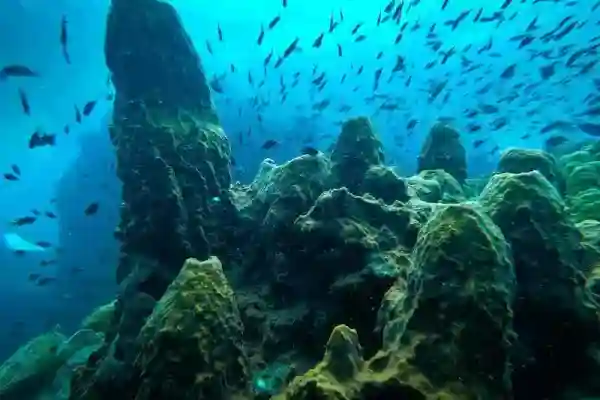

Dive Site Overview
| Max Depth | Average Visibility | Marine Life |
|---|---|---|
| 18 meters | 10–20 meters | Blacktip reef sharks, stingrays, moray eels, lionfish, boxfish |
Ready to discover this exclusive underwater world? Book your next fun dive or scuba diving course with Chang Diving Center today!
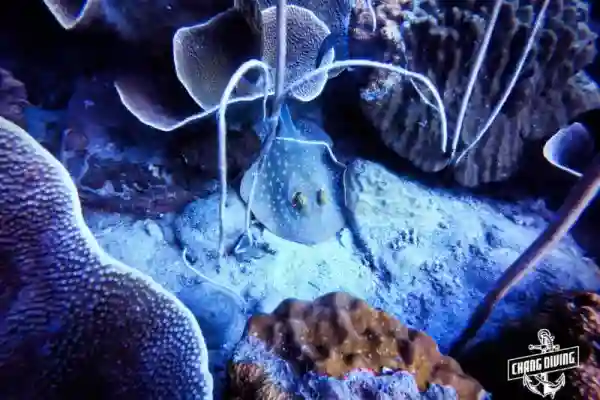


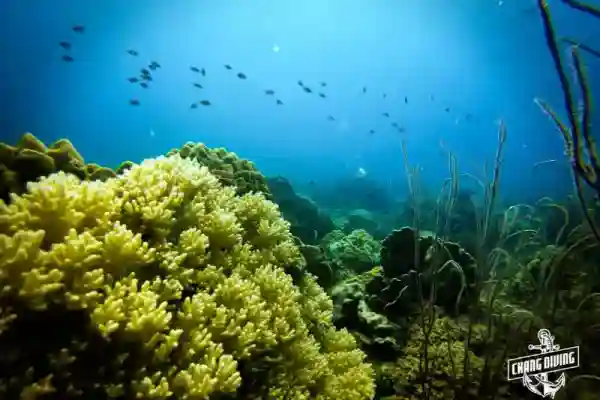
Diver Level for this dive site.
Min. certification level: Junior, Open Water Diver (or equalled) Try Diving possibility: Yes Snorkelling possibility: YesDive Briefing Example for Dive Professionals – Hin Raab North
This is a comprehensive dive briefing template/example for dive professionals. Use this as a reference guide to structure your own briefings. Customize the placeholders (marked with square brackets) with your specific information, guide names, and current conditions. This ensures a safe, organized, and professional dive briefing experience.
1. Dive Site Name & Introduction
Hello everyone and welcome to Hin Raab North! Hin Raab North is one of Koh Chang's most exclusive dive sites and boasts the greatest coral diversity of any dive site in Koh Chang. With both soft and hard corals creating a living tapestry, this site is like swimming through an underwater kindergarten where fish schools are so dense, you'll feel like you're swimming through fish rather than water.
My name is [Your Name] and I will be your dive guide today. I've been diving this site for [X] years and I'm excited to share this incredible place with you!
2. Site Description & Dive Route
We have excellent diving conditions today at Hin Raab North. Visibility is typically 10-20 meters, and we have calm surface conditions with minimal current.
- Maximum Depth: 18 meters
- Average Depth: 12-15 meters (main reef area)
- Dive Route: We'll descend along the mooring line at the northeast corner of the dive site. From there, we'll start heading south, then follow the reef edge westward. When we reach the second rock formation, we'll turn into a canyon heading northeast that leads us to a shallow middle platform at around 5 meters. This is where we'll conduct our swimming safety stop, following the reef edge eastward back toward the boat.
- Site Features: Two distinct rock formations break the surface, running east to west like natural landmarks. These formations anchor the entire ecosystem and serve as excellent navigation aids.
- Weather Conditions: [Current conditions - e.g. "Low tide, wave height 0.5 meters, light surface current"]
The site's topography creates dramatic underwater passages filled with colorful corals, and the shallow middle platform at 5 meters is perfect for our safety stop while still surrounded by incredible marine life.
What You Can See at Hin Raab North
Hin Raab North is a thriving coral reef that attracts an incredible diversity of marine life. During your dive, you can expect to see:
- Massive Fish Schools: Schools of barracuda patrol the edges like underwater sentinels, while batfish drift lazily overhead. Yellowback fusiliers form massive schools that create living walls of silver and yellow – it's like swimming through a fish market, except the fish are alive and wild!
- Coral Diversity: This site has the greatest coral diversity in Koh Chang, with both soft and hard corals creating a living tapestry that rivals the most famous reefs in Southeast Asia
- Large Pufferfish: The site's signature highlight – large pufferfish hover like curious, inflated balloons throughout the dive, their big eyes following your every move
- Reef Fish: Colorful reef fish of all sizes, from tiny gobies to larger groupers, creating a vibrant underwater ecosystem
- Occasional Visitors: Blacktip reef sharks, stingrays, moray eels, and lionfish are often spotted around the reef structure
For a complete guide to the marine life you might encounter while diving in Koh Chang, check out our Marine Life Guide. This comprehensive resource covers species identification, behavior, and the best spots to find various marine creatures.
3. Your Guide's Role & Positioning
I will be leading this dive and wearing [Color] and [Color] fins with a [Description of equipment/identifying feature]. You can easily identify me by [specific visual identifier - e.g. "my bright yellow BCD with the Chang Diving logo"].
[If applicable] Our Divemaster [Name] will be positioned at the back of the group, keeping an eye on everyone. [Name] will be wearing [Color] fins and will use [signal device - e.g. "this tank banger"] to get your attention if needed.
Important: Stay close to the group and maintain visual contact with your buddy and guide at all times. If you need to communicate, use standard hand signals or get my attention by tapping on your tank.
4. Entry & Exit Techniques
Boat Entry (Giant Stride)
We'll enter the water from the side of the dive boat with a Giant Stride. Here's what you should remember:
- Pre-Dive Safety Check: Complete your BIG WHALES REALLY ARE FUN check before entering the water
- BCD Inflation: Fully inflate your BCD before entry
- Regulator: Keep your regulator in your mouth
- Mask: Make sure your mask is properly fitted
- Entry: Step forward with one leg, then the other, keeping legs together
- After Entry: Clear the area immediately, signal OK, and swim to the mooring line
Boat Exit (Ladder)
After completing your safety stop and surfacing:
- Swim back to the ladder on the side of the boat
- Stand on the ladder and remove your fins (hand them to the crew)
- Climb up the ladder with your regulator still in your mouth
- CRITICAL: Never position yourself directly under another diver climbing the ladder
- Once on deck, move away from the entry/exit area
Dinghy Entry (Backroll)
If we're using a dinghy, we'll enter with a backroll entry:
- Sit on the edge of the dinghy with your back to the water
- Complete your pre-dive safety check
- Hold your mask and regulator in place
- On three, lean back and roll into the water
- Clear the area and signal OK
5. Dive Procedures & Turn-Around Points
To ensure we have enough air for a safe return and safety stop:
- Turn-Around Point: We'll turn the dive around when you reach 130 bar (or 1900 PSI). This gives us more than enough air reserve to safely return to the entry point and complete our safety stop.
- Air Monitoring: Check your air gauge frequently throughout the dive. Don't wait until you're low on air to signal – communicate early!
- Safety Stop: At 5 meters depth, we'll conduct a swimming safety stop for 3 minutes. This means we'll swim slowly along the reef edge heading eastward back toward the boat, maintaining 5 meters depth, rather than holding onto a line. The shallow middle platform provides perfect conditions for this.
- No-Decompression Limits: For this depth (12-18 meters), your no-decompression limit is approximately 50 minutes. We'll keep the dive well within these limits.
Remember: The most important rule in diving is to never hold your breath. Breathe normally and continuously throughout the entire dive.
6. Emergency Procedures
While we don't expect any problems, it's important that everyone knows what to do in an emergency:
Buddy Separation
- If you become separated from your buddy, search for 1 minute while staying at the same depth
- If you can't find your buddy, make a controlled safety ascent to the surface
- Wait at the surface – we'll reunite there
- DO NOT continue diving alone
Out of Air / Low on Air
- Low on Air: Signal immediately – we'll end the dive and ascend together
- Out of Air: Signal "out of air" and use your buddy's alternate air source or make a controlled emergency swimming ascent (CESA)
- Always signal problems early – don't wait until it's an emergency!
Emergency Contacts & Equipment
- Police: 191
- Tourist Police: 1155
- Emergency Medical Service: 1669
- DAN International: +1-919-684-9111 (24/7 emergency hotline for dive emergencies)
- Recompression Chamber: Koh Chang Hospital, Phone: 039 521-657 or 039 586-131
- Suspected DCS: See our DCS Field Evaluation Slate (PDF) for assessment procedures
- Emergency Oxygen: Located in the transport box on the right of the captain's seat in the captain's cabin
- First Aid Kit: Located in the transport box on the right of the captain's seat in the captain's cabin
- Emergency Action Plan: For detailed emergency procedures, see our Emergency Plan Guide
7. Hand Signal Review
Hand signals can vary between countries and certification agencies, so let's make sure we're all on the same page. Here are the essential signals we'll be using today:
- OK: [Description/visual] - Used to ask "Are you OK?" and respond "I'm OK"
- Problem: [Description/visual] - Hand waved side to side to indicate a problem
- Up: [Description/visual] - Thumbs up means "I want to go up"
- Down: [Description/visual] - Thumbs down means "I want to go down"
- Air Pressure: [Description/visual] - Show numbers with fingers (e.g. "I have 120 bar")
- Low on Air: [Description/visual] - Hand across throat
- Out of Air: [Description/visual] - Hand across throat, then point to regulator
- Safety Stop: [Description/visual] - Hand horizontal, palm down, at 5 meters
- Stop/Hold: [Description/visual] - Hand up, palm forward
- Look/Point: [Description/visual] - Point at something interesting
Practice Question: Can you show me how you would communicate that you still have 120 bar of air pressure?
📋 Download Complete Hand Signal Guide (PDF)
8. Roster & Buddy Check (Pairing)
Let's make sure everyone is here and properly paired:
- Roster Check: [Go through names] - Is everyone here?
- Buddy Pairs:
- [Name] and [Name] - you'll be buddies
- [Name] and [Name] - you'll be buddies
- [Name] - you'll be my buddy today (for less experienced divers)
- Buddy Check: Before entering the water, do a final check with your buddy – make sure all equipment is secure and functioning
Note: Buddy pairs are typically matched by experience level and certification. If you'd like to dive with a specific person, let me know now.
9. Environmental Awareness & Marine Hazards
Hin Raab North is a protected coral reef, and we must respect the marine environment:
- General Rule: Look but don't touch. Avoid contact with all marine life, including corals, sponges, and fish
- Marine Life to Be Aware Of:
- Lionfish: Beautiful but venomous – maintain a safe distance (at least 2 meters)
- Moray Eels: Usually shy but can be territorial – don't reach into holes or crevices
- Fire Coral: Can cause skin irritation – avoid contact
- Sea Urchins: Sharp spines – watch your hands and knees
- Pufferfish: Large pufferfish are common here – admire them from a distance, they can be defensive
- Buoyancy Control: Maintain good buoyancy to avoid damaging the reef or stirring up sediment
- Photography: If taking photos, be careful not to touch anything. Use a camera housing or handle
- Conservation: Take only photos, leave only bubbles. Never remove anything from the reef
Remember: We are guests in their home. Let's be respectful visitors and leave the place exactly as we found it.
10. Pre-Dive Safety Check
Before every dive, we use the acronym "BIG WHALES REALLY ARE FUN" to make sure nothing is forgotten. For a detailed guide on why safety checks are important and how to do them correctly, check out our Safety Check Guide:
- B - BCD: Check that your BCD inflates and deflates correctly. Test the power inflator and dump valves.
- I - Inflation: Make sure your BCD fits properly and all straps are secure.
- G - Gauges: Check your SPG (submersible pressure gauge), depth gauge, and computer. Make sure they're working and readable.
- W - Weights: Check that your weight belt or integrated weights are secure and properly positioned.
- H - Hose: Check all hoses for kinks or damage. Make sure your regulator hoses are routed correctly.
- A - Air: Turn on your air, check your tank pressure, and take 2-3 breaths from your regulator.
- L - Releases: Test all quick releases on your BCD, weight system, and any other equipment.
- E - Everything: Check once more that everything is in place and working.
- S - Snaps: Make sure all buckles and fasteners are secure.
- R - Releases: (Second check) Verify that all releases are functioning.
- E - Everything: Final check – is everything ready?
- A - Air: Final air check – regulator working, tank pressure good.
- L - Look: Look around – is your buddy ready? Is the entry area clear?
- L - Listen: Listen for final instructions from your guide.
- Y - You: Are YOU ready? Take a deep breath, relax, and enjoy the dive!
- A - Again: One more quick check – everything safe?
- R - Ready: Are you ready to dive?
- E - Everything: Final everything check.
- F - Fun: Remember – diving is FUN! Relax and enjoy!
- U - Underwater: Ready to go underwater?
- N - Now: Let's dive NOW!
Pro Tip: Do this check with your buddy. It's a great way to catch problems before entering the water and helps build confidence.
📋 Quick Briefing Checklist
- ✅ Site name and conditions understood
- ✅ Dive route and depths clear
- ✅ Guide identification confirmed
- ✅ Entry/exit procedures reviewed
- ✅ Turn-around points and air reserves understood
- ✅ Emergency procedures clear
- ✅ Hand signals reviewed
- ✅ Buddy paired and checked
- ✅ Environmental awareness discussed
- ✅ Pre-dive safety check completed
Questions? If you have any questions or concerns, please ask now - I'm here to help! Remember, there are no stupid questions when it comes to dive safety. Let's have a safe and amazing dive! 🌊🤿
📝 After Your Dive: Log Your Experience
Don't forget to log your dive! Your dive logbook is an important record of your diving experience and is required for many advanced courses. Whether you use a digital app or a traditional logbook, make sure to record:
- Date and location
- Dive site name (Hin Raab North)
- Maximum depth and dive duration
- Air consumption (start and end pressure)
- Your buddy and guide
- Highlights (marine life spotted, conditions, etc.)
For more information on why dive logbooks are important and what to include, check out our Dive Logbook Guide. You can find the dive site stamp and get your logbook signed by your guide at the coffee station on the boat.
What other divers discovered
Real reviews and experiences from our guests – see what others found on their diving adventures with us!
Similar Dive Sites
Explore more intermediate to advanced reef dives around Koh Chang. These sites offer similar depths and challenge levels.
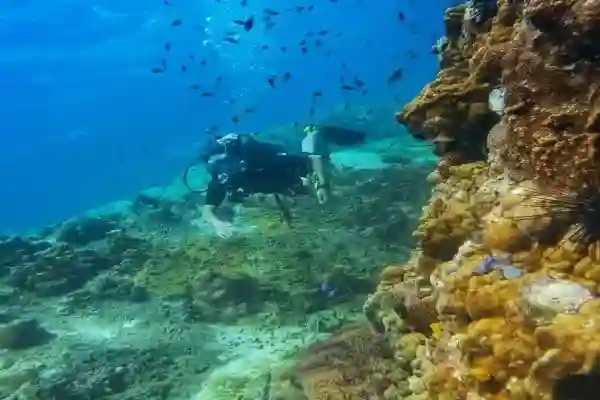
🌊 Hin Raab South
Exciting drift dive with coral walls. Sister site to the North. (Max depth: 25m)
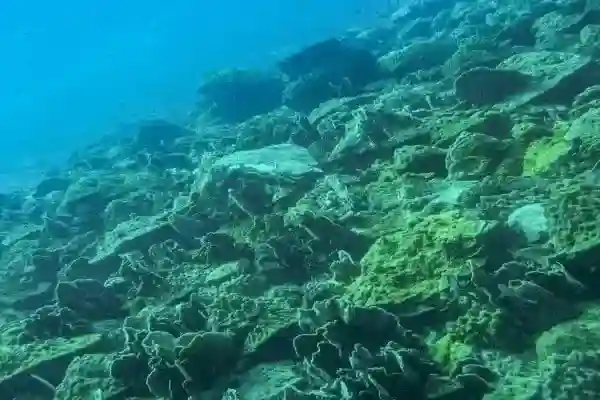
🫐 Blueberry Hill
Beautiful coral pinnacle with diverse marine life. (Max depth: 25m)
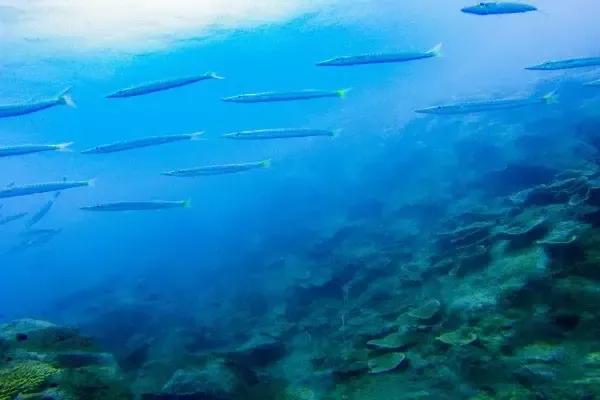
🏔️ Koh Rang Pinnacle
Dramatic pinnacle with strong currents. Advanced dive! (Max depth: 28m)
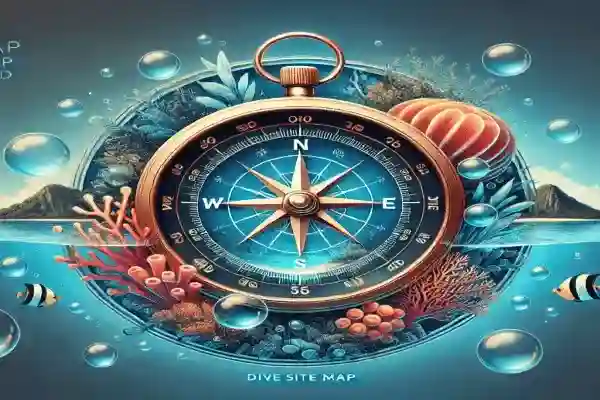
🗺️ View All Sites
Explore all 13 dive sites around Koh Chang.

